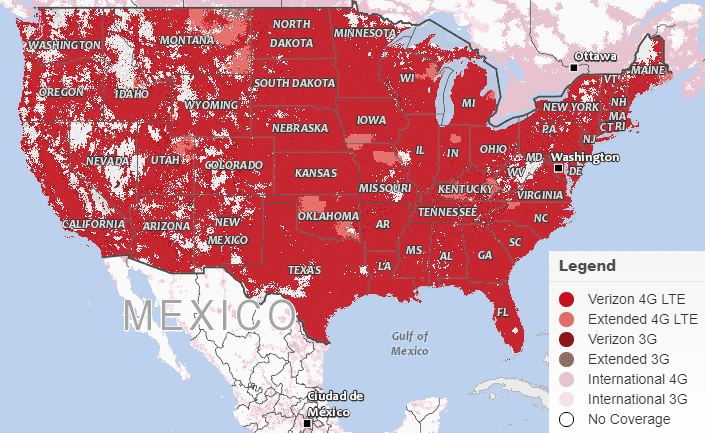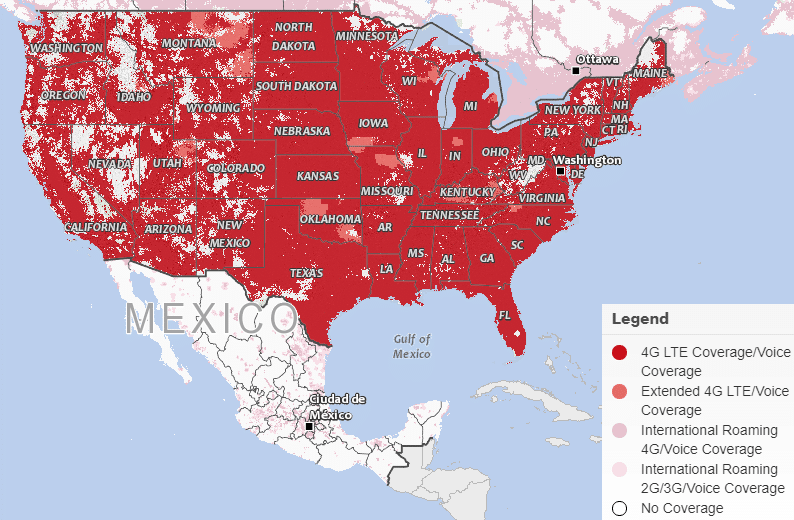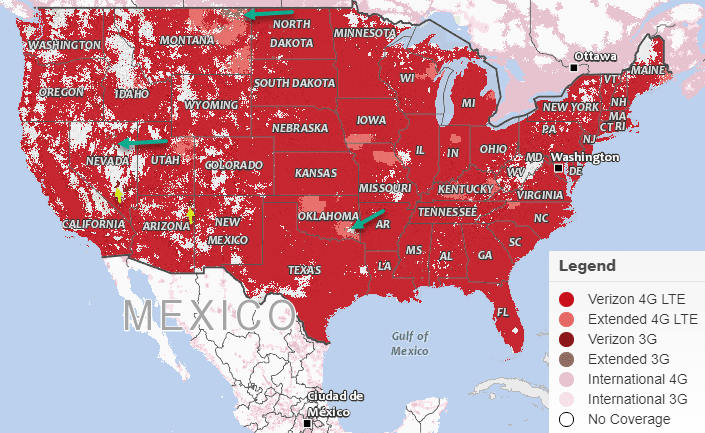Get Unlimited 5G for $25/month with Metro by T-Mobile.
Last updated: June 2020
Summary
As far as I can tell, Verizon’s prepaid subscribers are covered in all or nearly all the places that Verizon’s postpaid subscribers receive coverage. It looks like Verizon’s prepaid subscribers generally have access to the same extended network roaming partners that Verizon’s postpaid subscribers have access to.
Background
In 2019, I couldn’t find anywhere where Verizon clearly explained the difference between its prepaid coverage and postpaid coverage. Since I couldn’t find clear answers, I did a bit of digging around Verizon’s coverage maps. I share what I learned on this page. I’m not entirely confident about my assessment, and network coverage changes all the time. If you have any doubts, you may want to reach out to Verizon directly.
Coverage maps
As of April 2019, the interactive coverage map on Verizon’s website allows users to select one of four options for viewing coverage information:
- 4G LTE Coverage
- 4G LTE without 3G CDMA
- 3G/1X Coverage
- Prepay Voice & Data
Here’s what that map looks like with the default “4G LTE Coverage” option selected:

With the “Prepay Voice & Data” option selected, the map looks quite similar:

It looks like both maps show extended (roaming) 4G LTE coverage in the same (or nearly the same) places. My impression is that subscribers to both Verizon’s prepaid and postpaid service can roam in the extend 4G areas at no extra charge.1 The only obvious differences in the national maps are areas with 3G coverage. Even those differences are hard to see since the regions are so small. I’ve added arrows to the first map to indicate a few of the places where postpaid subscribers have network access that prepaid subscribers may not. Green arrows indicate areas covered by extended 3G networks and yellow arrows indicate areas covered by Verizon’s 3G networks.2

The differences in coverage are probably unimportant for most consumers given (a) how small the regions are and (b) Verizon’s plan to largely retire its 3G network by the end of 2020. In fact, I’m not confident that prepaid subscribers are totally unable to access Verizon’s network in areas I marked with arrows (if network access in those areas is important to you, see the following footnote).3
Coverage with Verizon-based MVNOs
I’ve found it difficult to figure out how the coverage offered by mobile virtual network operators (MVNOs) that run over Verizon’s network compares to the coverage that that Verizon’s own prepaid and postpaid subscribers receive. I’m suspicious that MVNOs running over Verizon typically have a smaller coverage profile than Verizon itself.
Through its LTE in Rural America (LTEiRA) program, Verizon partners with 20 or so regional network operators.4 Verizon’s direct customers can access these regional operators’ networks. It’s unclear whether subscribers on Verizon-based MVNOs can access these networks. The best discussion I’ve seen on this topic comes from a post on HowardForums started in August 2019. I’m not certain, but the post leads to to believe most people using Verizon-based MVNOs cannot access most LTEiRA networks at this time.
Footnotes
- Verizon’s Domestic Roaming FAQ states the following (as of 4/29/2019):
“Will I be charged differently when using my device while roaming domestically?
No, with the exception of a few old plans.Please refer to the My Plan page in My Verizon for the roaming details of your specific plan. If no information about roaming is listed, then there are no additional charges for roaming domestically.”
It’s unclear if this excerpt necessarily applies to prepaid subscribers. Earlier in the FAQ, the following statement is made:
“For information about prepaid service and domestic roaming, refer to our Prepaid Service FAQs.”
Unfortunately, I did not find Prepaid Service FAQs helpful for clearing up questions about domestic roaming. However, users on a Reddit thread suggest that there are no charges associated with most domestic, 4G roaming on Verizon’s prepaid plans.
- These arrows are not comprehensive. Some areas without arrows may not be covered by prepaid service.
- Verizon’s FAQ for prepaid subscribers states the following (as of 4/29/2019):
“Prepaid service is available in the Prepaid Rate and Coverage Area. To see where prepaid service is available:
Go to our Interactive coverage map.
Tap or click the Menu icon in the top left corner of the map.
Select Prepaid.
The prepaid coverage map will display.Calls made or received outside of this calling area will be charged at a roaming rate. See the Prepaid International page for rate details.”
The excerpt seems to indicate that it may be possible for prepaid users to roam in additional, domestic areas. However, the suggestion to view the Prepaid International page for more information may indicate that Verizon only meant to imply prepaid customers could roam outside of the U.S.
I’ve seen information suggesting that 3G roaming is (or at least was) possible with modest charges. I haven’t confirmed that this kind of roaming is still possible.
- A FierceWireless article from 2015 indicated that Verizon had 21 LTEiRA partners. I’m not sure how many partners there are today.

I have been with Verizon (originally postpaid) and now 3 years with prepaid, I had a motorola turbo droid Verizon phone from postpaid.When I dropped it in the river, i purchased a several other Motorola phones and experienced failed calls ans speaker issues. I exercised my warranty on my Moto G6 3 times, The last time Motorola checked my signal strength and it measured -117 mBd. I can check my signal strength and have over the last 2 weeks wherever I go and it is consistently over -100 or more with only a few exceptions dropping as low as -88 only briefly. I have gone into The Verizon store on different occasions and spoke with different representatives. They both immediately said I get poor signal because I am on prepaid and don’t pay for unlimited data. I was told there and also in a phone conversion with a postpaid representative, “You pay less, you get less”. I did have a tech support person insist that it is the phone and told that only expensive phones such as Iphones will perform well. I do have a very inexpensive LG verizon I purchased when the phone went in the river. I have been switching my sim card and checking signal strength on both phones wherever I go and the number are the same. I live in a major suburb of Atlanta but do travel to areas that only have Verizon. I This is not being discussed,Either Verizon is limiting use of towers to prepaid or all their representatives are lying to try to get you to buy postpaid. I’m reaching a point, as a matter of principle I cannot continue with Verizon.
Hmm. I bet the support agents are wrong, but I’m not sure what the source of the issue is.
I’m not a true expert on network hardware, but it seems very odd to me that a phone with prepaid service would get a weaker signal than a phone with postpaid service (if the prepaid phone received lower priority, that would make more sense). Did the issue only start recently? What kind of LG phone do you have?
I have had verizon service for at least 15 years. Recently i have had problems with overbillimg and mistakes on our postpaid account, so i figured i would go to prepaid and solve the problem. After researching and some discussion with verizon, i was told the service would be the same, just one is pre pay and the other is billed. Biggest lie ever. I now roam in areas where i had 4g lte. The data speeds are outragiously slow compared to before. If told you are not capped at congested times, its a lie. As a post paid customer i could always load anything instantly. Now, just to load a simple web page could take 2 mins. I am now searching other companies in the area to see who can give me the best deal. I pay just as much prepay as i did postpay and the service sucks. I have family beside me with verizon post pay and with straight talk that can literally make my service look like an old dial up internet connection.
Exactly my experience!
In my area, you won’t get the same coverage with prepaid as you can with postpaid. Also, you can’t use a Verizon network extender unless you have postpaid. So if prepaid doesn’t have reception in your area, you have to get postpaid and a network extender.